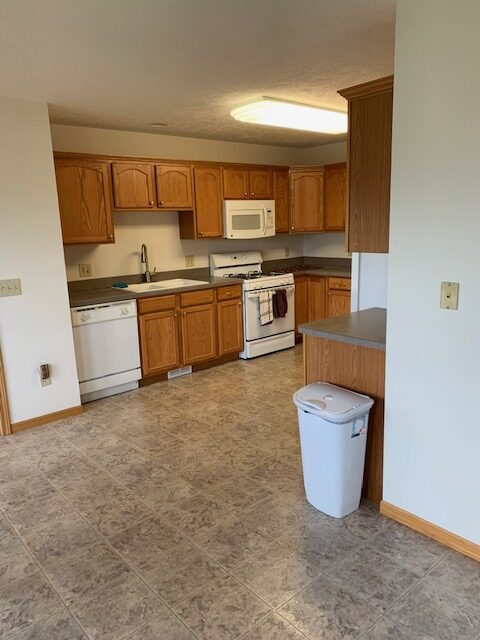Stay Comfortable in Your Kitchen as You Age
As homeowners age, their needs change, and creating a kitchen that is both functional and safe becomes a priority. Whether you are planning for your own future or remodeling a kitchen for an aging loved one, designing a space that promotes comfort, accessibility, and safety is essential.
Aging in place means staying in your home as long as possible while maintaining independence. Since the kitchen is one of the most frequently used areas in the house, adapting it to accommodate mobility challenges, changing physical abilities, and safety concerns can significantly enhance the quality of life.
This guide will help you design a senior-friendly kitchen that balances safety, convenience, and style while ensuring it remains a welcoming and practical space for years to come.

Creating an Accessible Layout for Easy Movement
The first step in designing an age-friendly kitchen remodel is ensuring that the layout is spacious and easy to navigate. A well-planned kitchen should reduce unnecessary strain and allow homeowners to move freely without obstacles.
Prioritizing an Open Layout
- Eliminate tight spaces by widening pathways to at least 42-48 inches to accommodate wheelchairs or walkers if necessary.
- Consider an L-shaped or U-shaped layout, which allows for efficient movement and easy access to appliances.
- Lower countertops and islands to provide a comfortable workspace for individuals who may need to sit while preparing food.
Reduce the Need for Excessive Bending or Reaching
- Install pull-out shelves and lazy Susans in cabinets for easy access to stored items.
- Use deep drawers instead of lower cabinets to prevent bending and straining when retrieving kitchen essentials.
- Place frequently used appliances (like microwaves and ovens) at waist or counter height to avoid the need for overhead lifting.
Choosing Ergonomic and Easy-to-Use Appliances
As mobility and dexterity decrease with age, kitchen appliances should be user-friendly, intuitive, and easy to operate.
Essential Features in Age-Friendly Appliances
- Induction Cooktops: These are safer than gas or electric stoves since they only heat up when cookware is placed on them, reducing the risk of burns.
- Side-Opening Ovens: Traditional drop-down oven doors can be difficult to maneuver around. A side-opening oven at counter height is much easier to use.
- Drawer-Style Dishwashers: Instead of bending down to load and unload dishes, drawer-style dishwashers are installed at waist height, making them more accessible.
- Smart Refrigerators: With adjustable shelves and pull-out bins, smart refrigerators make it easy to organize food without excessive reaching or bending.
Appliance Placement for Convenience
- The microwave should be placed at or just below counter height to prevent lifting hot items overhead.
- Install touch-control induction cooktops instead of traditional knobs to make temperature adjustments easier.
- Position the dishwasher near the sink to minimize movement when loading and unloading dishes.
Installing Safe and Slip-Resistant Flooring
Kitchen floors can be a major hazard for aging individuals, as spills and slick surfaces can lead to slips and falls. Choosing the right flooring material can reduce the risk of accidents while maintaining a stylish look.
Best Flooring Options for Safety
- Cork Flooring: Soft underfoot and provides natural shock absorption, making it a great choice for reducing fatigue.
- Textured Vinyl Flooring: Offers a non-slip surface while being easy to clean and maintain.
- Matte-Finished Tile: Choose larger, textured tiles with narrow grout lines to prevent tripping hazards.
- Hardwood or Laminate with Non-Slip Coating: Provides warmth and a traditional look, but should be finished with a non-slip treatment for added safety.
Avoid These Flooring Pitfalls
- Avoid glossy tiles or polished stone, as they become extremely slippery when wet.
- Keep rugs secured with anti-slip pads or opt for rubber-backed mats to prevent slipping.
- If replacing flooring is not an option, consider adding foam mats in high-traffic areas like near the sink or stove for extra cushioning.
Enhancing Kitchen Safety with Smart Technology
Modern technology can make kitchen remodeling safer and easier to use for aging homeowners. From smart appliances to hands-free lighting, incorporating these innovations can enhance independence and safety.
Motion-Activated and Hands-Free Features
- Touchless Faucets: Reduce strain on arthritic hands by eliminating the need to turn knobs.
- Motion-Sensor Lights: Install under-cabinet lighting or automatic floor lights that turn on when motion is detected.
- Voice-Controlled Assistants: Smart home assistants (like Alexa or Google Home) can set timers, play music, or even read out recipes hands-free.
Smart Safety Devices
- Auto Shut-Off Stovetops: Prevent fires by installing stovetops with automatic shut-off timers.
- Leak Detection Sensors: Place sensors near the sink and dishwasher to detect leaks early and prevent water damage.
- Smoke and Carbon Monoxide Detectors: Opt for models with loud alarms and flashing lights to alert homeowners with hearing impairments.
Designing Easy-to-Maintain Storage Solutions
As mobility and strength decline, traditional kitchen storage can become difficult to access. Upgrading to more ergonomic storage solutions with kitchen remodeling makes it easier to keep items organized and within reach.
Smart Cabinet and Drawer Designs
- Pull-Down Shelves: Bring upper cabinet contents down to counter level with easy-to-use pull-down shelving systems.
- Soft-Close Drawers: Reduce strain on hands by installing drawers with soft-close mechanisms that glide smoothly.
- Under-Counter Storage for Heavy Items: Store pots, pans, and small appliances in drawers rather than overhead cabinets to minimize lifting strain.
Functional Pantry Organization
- Use slide-out pantry shelves to improve visibility and accessibility.
- Label pantry items clearly to make locating ingredients easier.
- Install lazy Susans in corner cabinets for better access to stored food.
Improving Lighting for Visibility and Safety
Aging can lead to reduced vision and depth perception, making it crucial to improve lighting in the kitchen.
Layered Lighting for Maximum Visibility
- Task Lighting: Install bright LED under-cabinet lights for meal preparation areas.
- Ambient Lighting: Choose adjustable ceiling fixtures that illuminate the entire kitchen remodel evenly.
- Toe-Kick Lighting: Placing soft LED strips along the base of cabinets can help seniors navigate safely at night.
Reducing Glare and Shadows
- Use warm white or daylight LED bulbs instead of harsh fluorescent lighting.
- Avoid high-gloss surfaces that reflect excessive light and create glare.
Choosing Senior-Friendly Countertops and Work Surfaces
Countertops are a vital component of any kitchen remodeling, and for aging homeowners, they should be designed for both comfort and safety. The right countertop height, material, and edge design can reduce strain, prevent injuries, and enhance usability.
Optimal Countertop Heights and Multi-Level Workstations
- Standard countertops are typically 36 inches high, but for aging individuals who may use a wheelchair or prefer to sit while prepping food, lowered sections (30-32 inches) can improve accessibility.
- Consider a multi-level workstation that includes both standard and lowered countertops to accommodate various needs.
- A roll-under counter or open space beneath the sink makes it easier for individuals with mobility limitations to use the kitchen independently.
Best Countertop Materials for Safety and Durability
- Quartz: A non-porous, low-maintenance material that resists stains and scratches.
- Solid Surface (e.g., Corian): Seamless, easy to clean, and repairable if damaged.
- Laminate: A budget-friendly option with many designs, though it lacks the durability of quartz or solid surfaces.
Avoid highly polished materials like marble or high-gloss granite, as they can create glare and be slippery when wet.
Safe and Ergonomic Edge Profiles
- Sharp-edged countertops can pose a risk for bruises and injuries, especially in an age-friendly kitchen remodeling.
- Rounded or bullnose edges help prevent painful bumps and cuts.
- Waterfall edges (where the countertop extends to the floor) provide a sleek look while eliminating sharp corners.
By selecting countertops that are accessible, safe, and easy to maintain, homeowners can create a kitchen that remains functional and stylish for years to come.
Seating and Dining Areas for Comfort and Accessibility
A well-designed kitchen should be more than just a space for cooking—it should also offer a comfortable and inviting place to dine and socialize. Seniors benefit from ergonomic seating, accessible table heights, and multi-use spaces that cater to different needs.
Comfortable Seating for Everyday Use
- Opt for padded, high-back chairs with armrests to provide better support for sitting and standing.
- Use bench seating with cushions for extra comfort in breakfast nooks.
- Consider adjustable-height barstools for kitchen islands to accommodate different seating preferences.
Accessible Dining Table Heights
- Standard dining tables are 28-30 inches high, but a counter-height table (34-36 inches) can be a more accessible option for those who struggle with bending down.
- Ensure there is at least 30-36 inches of clearance around dining areas to allow for wheelchairs or walkers.
Multi-Use Dining Spaces
- A kitchen island with an extended countertop can serve as both a dining table and a prep space.
- Install built-in banquettes for a cozy, space-saving solution that accommodates both dining and socializing.
- Consider a foldable or extendable table that can adapt for larger gatherings or be tucked away when not in use.
By creating a versatile and comfortable dining space, the kitchen can serve as a gathering place that encourages independence and enhances quality of life for aging homeowners.
A Kitchen Remodeling for Every Stage of Life
Adapting a kitchen for aging in place is about enhancing safety, accessibility, and functionality while maintaining a stylish and inviting space. By incorporating ergonomic appliances, smart technology, non-slip flooring, and well-planned storage, homeowners can create a kitchen remodeling that supports independence and comfort for years to come.
Whether you’re remodeling for yourself or a loved one, making thoughtful design choices today can prevent challenges in the future and ensure a home that adapts to every stage of life. Investing in an age-friendly kitchen remodel is not just a practical decision—it’s a step toward a safer, more comfortable, and worry-free home.



